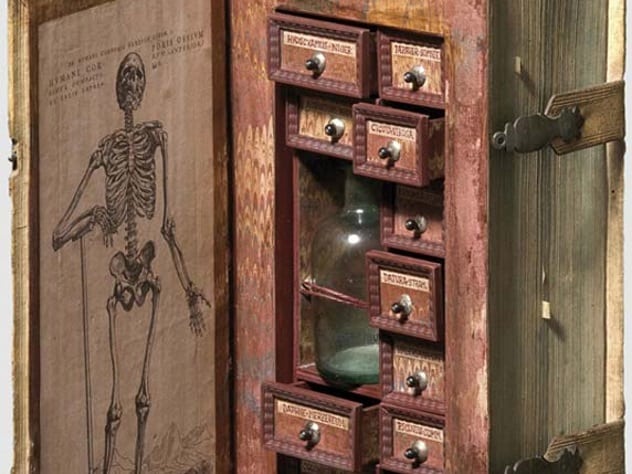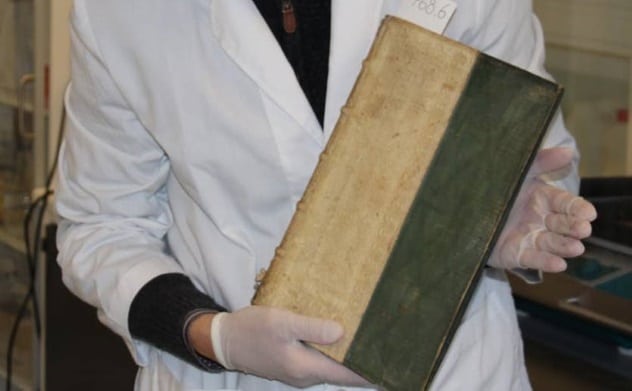 Technology
Technology  Technology
Technology  Humans
Humans 10 Everyday Human Behaviors That Are Actually Survival Instincts
 Animals
Animals 10 Animals That Humiliated and Harmed Historical Leaders
 History
History 10 Most Influential Protests in Modern History
 Creepy
Creepy 10 More Representations of Death from Myth, Legend, and Folktale
 Technology
Technology 10 Scientific Breakthroughs of 2025 That’ll Change Everything
 Our World
Our World 10 Ways Icelandic Culture Makes Other Countries Look Boring
 Misconceptions
Misconceptions 10 Common Misconceptions About the Victorian Era
 Mysteries
Mysteries 10 Strange Unexplained Mysteries of 2025
 Miscellaneous
Miscellaneous 10 of History’s Most Bell-Ringing Finishing Moves
 Technology
Technology Top 10 Everyday Tech Buzzwords That Hide a Darker Past
 Humans
Humans 10 Everyday Human Behaviors That Are Actually Survival Instincts
 Animals
Animals 10 Animals That Humiliated and Harmed Historical Leaders
Who's Behind Listverse?

Jamie Frater
Head Editor
Jamie founded Listverse due to an insatiable desire to share fascinating, obscure, and bizarre facts. He has been a guest speaker on numerous national radio and television stations and is a five time published author.
More About Us History
History 10 Most Influential Protests in Modern History
 Creepy
Creepy 10 More Representations of Death from Myth, Legend, and Folktale
 Technology
Technology 10 Scientific Breakthroughs of 2025 That’ll Change Everything
 Our World
Our World 10 Ways Icelandic Culture Makes Other Countries Look Boring
 Misconceptions
Misconceptions 10 Common Misconceptions About the Victorian Era
 Mysteries
Mysteries 10 Strange Unexplained Mysteries of 2025
 Miscellaneous
Miscellaneous 10 of History’s Most Bell-Ringing Finishing Moves
10 Extremely Poisonous Historical Items
When dealing with items in museum collections or newly discovered artifacts at archaeological digs, it’s easy to get excited and want a close look. However, sometimes, these objects of interest contain deadly surprises. They may be covered in poisonous material or have a lethal substance hidden within.
In the past, toxic chemicals were sometimes used in everyday items, such as asbestos being used in a multitude of daily goods before its detrimental health effects were discovered.[1] Poisons were also used throughout history in order to, for example, get rid of political rivals or problematic lovers. So sometimes, items discovered today are revealed to be deadly to those who handle them or to hide secret poisons.
10 Suicide Glasses

The International Spy Museum in Washington, DC, has a pair of glasses with a sneaky little secret.[2] Inside the temple tip, there is a small cyanide pill that, if ingested, is deadly.
If a secret agent was captured and was at risk of giving up classified information, they could casually start chewing on their glasses. This would release the pill inside the plastic, resulting in a swift death for the agent and protection of their secrets. These glasses are traced back to the CIA, though similar items would have been used by other agencies, too.
9 Assassin’s Book

In 2008, a German auction house listed a 17th-century faux book that concealed an array of poisons.[3] The book had all its pages glued together, with the inside carved out. Instead, 11 small drawers were placed there, each with a label naming a poisonous plant. The book also contained a small green jar and a drawing of a skeleton.
The drawers were empty, and an analysis of any residual traces of poison has yet to be conducted, but the book has been speculated to have belonged to an assassin. As it is from a time when poison and medicine were highly similar, it has also been theorized to have belonged to a healer. However, three of the drawers list wolfsbane, cowbane, and spurge laurel, which are highly toxic and were not, that we know of, used for medicinal purposes at the time.
8 Deadly Bacteria

It’s not exactly poison, but in 2017, an 800-year-old skeleton containing bacteria was discovered in Northwestern Turkey.[4] The skeleton belonged to a pregnant woman in her thirties who had two calcified nodules below her lower ribs. When they were analyzed, researchers discovered that they contained the bacteria Staphylococcus saprophyticus and Gardnerella vaginalis. The bacteria are likely what killed the woman.
For ancient DNA, usually less than one percent of it survives in the archaeological record. In this case, 31 to 58 percent of the DNA they recovered came from the bacteria.
7 Fatal Books

Three books in the library collection at the Southern University of Denmark were discovered, by chance, to contain deadly levels of arsenic.[5] The books, detailing various historical topics, are from the 16th and 17th centuries. Many books from this time reused old writings in their bindings, such as copies of old Roman laws. Researchers were trying to read and analyze these texts, but there was a green paint obscuring them. They had the books X-rayed in order to see the text better. Rather than discovering old writings, they found that the green paint was made up of arsenic, at a deadly dose.
Arsenic used to be employed to make vibrant green paints before people realized it was poisonous and could cause cancer and death. The arsenic on the books is believed to have been applied to prevent vermin and insects from ruining them, as it is not on the top layer and thus isn’t decorative.
6 Lethal Wallpaper

Arsenic is also present in a sample of wallpaper displayed at the Cooper Hewitt, Smithsonian Design Museum in Manhattan.[6] Green wallpaper used to fade quickly and turn an undesirable brown shade before 1775, when a green pigment, named Scheele’s green, was invented using arsenic. However, this meant that people’s houses were slowly poisoning them. When the wallpaper reacted with moisture in the air, the arsenic would be released in gaseous form. Sadly enough, children died in their own bedrooms from breathing this in.
The museum’s piece of wallpaper is from 1836, and although most of it is faded, the green parts are still bright today. Handling the paper too much would expose a person to arsenic and consequent poisoning, so the piece is placed behind glass while displayed or wrapped up securely if in storage.
5 Dangerous Fashion

Many items from history revealed to be poisonous were so due to arsenic, as it was also used to dye dresses and headdresses green in the Victorian era. After the death in 1861 of a young woman who made green artificial flowers for headdresses, the green dye was investigated. A doctor calculated that a headdress would, on average, contain enough arsenic to poison 20 people.[7] A ball gown often had 900 grains of arsenic, of which about 60 grains would probably shed in a single evening. As only four to five grains is lethal to an adult, this was a worrisome find.
It wasn’t just those who wore the clothes and their friends who were affected; the people who made the items suffered more. Being exposed to arsenic every day, those who worked with green clothes and accessories often got extremely ill. The York Castle Museum has placed one of these dangerous green ball gowns on display. To handle the dress, the curators have to wear gloves to avoid exposure, as arsenic still covers the fabric.
4 Mad Hats

It wasn’t just arsenic that made clothing dangerous in the past; felt hats laced with mercury also caused severe illness in their makers in Britain and France.[8] Hatmakers in the 18th and 19th centuries started using mercury to treat the hare and rabbit fur used to create the felt. While doing this, they would be breathing in the mercury, which went straight to their brains. Mercury poisoning starts with uncontrolled shaking and drooling and results in loss of teeth, cardiorespiratory problems, extreme paranoia, hallucinations, and death.
The hatmakers were the ones who suffered, as the wearers were protected from the mercury due to the lining in their hats. For this reason, mercury never became illegal in hatmaking, and it only stopped being used when felt hats went out of fashion. One such hat is preserved at the Bata Shoe Museum in Toronto. Dated to the 19th century, tests have confirmed that it still contains mercury.
3 Toxic Clothing

In 2018, a burial from between 1399 and 1475 containing the mummies of two girls, aged nine and 18, was found at Cerro Esmeralda in Northern Chile.[9] They were lavishly adorned, including bright red clothes. A chemical analysis of the clothing found that instead of using iron hematite to attain the red shade, as was common at the time, the makers had used cinnabar, which contains high levels of mercury.
The closest cinnabar mine was more than 1,600 kilometers (1,000 mi) away, north of modern-day Lima, Peru. Since the chemical would not have been that easy to acquire, it is speculated that the burial was highly important and that the cinnabar was knowingly added to keep grave robbers away.
2 Poisoned Arrows

Poisoning arrow tips is a practice that has been employed in many places around the world, so when the Victoria and Albert Museum in England received a collection of items, including arrows, from the East India Company in 1880, it was not a big deal that an early note for them stated that they were poisoned.[10] However, when they had them analyzed in more recent times, they were surprised to find that the particular poison used could be active for 1,300 years and still be able to kill someone today.
The arrows came from Assam as well as the Karen people in Burma, who would use the poisoned arrows to hunt animals for food. The poison comes from the sap or crushed seeds of local trees and is smeared onto the arrowhead. If it gets into the bloodstream, it causes paralysis, seizures, and cardiac arrest.
1 Pillbox Ring

A pillbox ring, a ring with a small container used to store something, was discovered in Cape Kailakra, Bulgaria, in 2013.[11] Of the over 30 pieces of jewelry found, this was the only piece with a secret compartment. It is believed to have been used as a poison ring, with a small hole on the side that could be used to quickly slip poison into someone’s drink.
The ring dates to the 14th century and is believed to have belonged to Dobrotitsa, a noble who ruled the area in the second half of the century. This ring may have been the reason so many other high-ranking members of society who were close to him died for unexplained reasons.
Read about more surprisingly dangerous objects on 10 Most Deadly Rocks and Minerals and 10 Deadly Household Items You’ve Probably Used Today.








